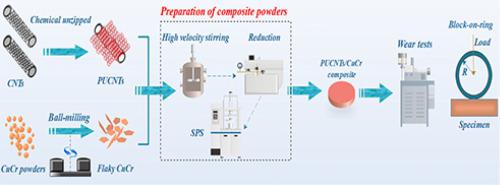当前位置:
X-MOL 学术
›
Diam. Relat. Mater.
›
论文详情
Our official English website, www.x-mol.net, welcomes your
feedback! (Note: you will need to create a separate account there.)
Effects of the partially-unzipped carbon nanotubes on the microstructure and properties of CuCr matrix composites
Diamond and Related Materials ( IF 4.3 ) Pub Date : 2020-11-01 , DOI: 10.1016/j.diamond.2020.108035 Qi Zhao , Qian Lei , Xueping Gan , Long Zhang , Kechao Zhou
Diamond and Related Materials ( IF 4.3 ) Pub Date : 2020-11-01 , DOI: 10.1016/j.diamond.2020.108035 Qi Zhao , Qian Lei , Xueping Gan , Long Zhang , Kechao Zhou

|
Abstract Poor interfacial adhesion and the aggregation of carbon nanotubes (CNTs) are important factors that restrict effective synthesis in CNTs-reinforced copper matrix composites (CMCs). Here, chemical unzipping and matrix-alloying (addition of Cr) methods were integrated to address these two limitations of CMCs. The CuCr matrix composite reinforced with partially-unzipped CNTs (PUCNTs) was manufactured using flake powder metallurgy and spark plasma sintering (SPS) processes. The effects of PUCNTs on microstructure, microhardness, electrical conductivity, and tribological properties of the composites were studied. The results showed that the in-situ interfacial carbides (Cr7C3 or Cr23C6) improved interfacial adhesion between PUCNTs and CuCr matrix. Additionally, the microhardness and tribological performances of PUCNTs/CuCr composites were obviously improved with increased concentrations of PUCNTs. When the PUCNTs content reached 8 vol%, the microhardness of the PUCNTs/CuCr composite was about 116% and 63% higher than that of unreinforced CuCr and CNTs/CuCr composite, respectively. The coefficient of friction and wear rate of the PUCNTs/CuCr composite were about 70% and 68% lower, respectively, than those of unreinforced CuCr. A balance was obtained between the electrical conductivity and tribological properties of the PUCNTs/CuCr composite. The results of this study show PUCNTs are better reinforcement fillers than CNTs, and suggest a new strategy for the fabrication of sliding electrical contact composites with high performance.
中文翻译:

部分解链碳纳米管对CuCr基复合材料微观结构和性能的影响
摘要 界面附着力差和碳纳米管(CNTs)的聚集是限制碳纳米管增强铜基复合材料(CMCs)有效合成的重要因素。在这里,化学解链和基体合金化(添加 Cr)方法被整合以解决 CMC 的这两个局限性。使用片状粉末冶金和放电等离子烧结 (SPS) 工艺制造用部分未压缩的 CNT (PUCNT) 增强的 CuCr 基复合材料。研究了PUCNTs对复合材料微观结构、显微硬度、电导率和摩擦学性能的影响。结果表明,原位界面碳化物(Cr7C3 或 Cr23C6)提高了 PUCNTs 和 CuCr 基体之间的界面附着力。此外,PUCNTs/CuCr复合材料的显微硬度和摩擦学性能随着PUCNTs浓度的增加而明显提高。当PUCNTs含量达到8vol%时,PUCNTs/CuCr复合材料的显微硬度分别比未增强CuCr和CNTs/CuCr复合材料的显微硬度高约116%和63%。PUCNTs/CuCr 复合材料的摩擦系数和磨损率分别比未增强的 CuCr 低 70% 和 68%。在 PUCNTs/CuCr 复合材料的导电性和摩擦学性能之间获得了平衡。这项研究的结果表明,PUCNTs 是比 CNTs 更好的增强填料,并提出了一种制造高性能滑动电接触复合材料的新策略。当PUCNTs含量达到8vol%时,PUCNTs/CuCr复合材料的显微硬度分别比未增强CuCr和CNTs/CuCr复合材料的显微硬度高约116%和63%。PUCNTs/CuCr 复合材料的摩擦系数和磨损率分别比未增强的 CuCr 低 70% 和 68%。在 PUCNTs/CuCr 复合材料的导电性和摩擦学性能之间获得了平衡。这项研究的结果表明,PUCNTs 是比 CNTs 更好的增强填料,并提出了一种制造高性能滑动电接触复合材料的新策略。当PUCNTs含量达到8vol%时,PUCNTs/CuCr复合材料的显微硬度分别比未增强CuCr和CNTs/CuCr复合材料的显微硬度高约116%和63%。PUCNTs/CuCr 复合材料的摩擦系数和磨损率分别比未增强的 CuCr 低 70% 和 68%。在 PUCNTs/CuCr 复合材料的导电性和摩擦学性能之间获得了平衡。这项研究的结果表明,PUCNTs 是比 CNTs 更好的增强填料,并提出了一种制造高性能滑动电接触复合材料的新策略。PUCNTs/CuCr 复合材料的摩擦系数和磨损率分别比未增强的 CuCr 低 70% 和 68%。在 PUCNTs/CuCr 复合材料的导电性和摩擦学性能之间获得了平衡。这项研究的结果表明,PUCNTs 是比 CNTs 更好的增强填料,并提出了一种制造高性能滑动电接触复合材料的新策略。PUCNTs/CuCr 复合材料的摩擦系数和磨损率分别比未增强的 CuCr 低 70% 和 68%。在 PUCNTs/CuCr 复合材料的导电性和摩擦学性能之间获得了平衡。这项研究的结果表明,PUCNTs 是比 CNTs 更好的增强填料,并提出了一种制造高性能滑动电接触复合材料的新策略。
更新日期:2020-11-01
中文翻译:

部分解链碳纳米管对CuCr基复合材料微观结构和性能的影响
摘要 界面附着力差和碳纳米管(CNTs)的聚集是限制碳纳米管增强铜基复合材料(CMCs)有效合成的重要因素。在这里,化学解链和基体合金化(添加 Cr)方法被整合以解决 CMC 的这两个局限性。使用片状粉末冶金和放电等离子烧结 (SPS) 工艺制造用部分未压缩的 CNT (PUCNT) 增强的 CuCr 基复合材料。研究了PUCNTs对复合材料微观结构、显微硬度、电导率和摩擦学性能的影响。结果表明,原位界面碳化物(Cr7C3 或 Cr23C6)提高了 PUCNTs 和 CuCr 基体之间的界面附着力。此外,PUCNTs/CuCr复合材料的显微硬度和摩擦学性能随着PUCNTs浓度的增加而明显提高。当PUCNTs含量达到8vol%时,PUCNTs/CuCr复合材料的显微硬度分别比未增强CuCr和CNTs/CuCr复合材料的显微硬度高约116%和63%。PUCNTs/CuCr 复合材料的摩擦系数和磨损率分别比未增强的 CuCr 低 70% 和 68%。在 PUCNTs/CuCr 复合材料的导电性和摩擦学性能之间获得了平衡。这项研究的结果表明,PUCNTs 是比 CNTs 更好的增强填料,并提出了一种制造高性能滑动电接触复合材料的新策略。当PUCNTs含量达到8vol%时,PUCNTs/CuCr复合材料的显微硬度分别比未增强CuCr和CNTs/CuCr复合材料的显微硬度高约116%和63%。PUCNTs/CuCr 复合材料的摩擦系数和磨损率分别比未增强的 CuCr 低 70% 和 68%。在 PUCNTs/CuCr 复合材料的导电性和摩擦学性能之间获得了平衡。这项研究的结果表明,PUCNTs 是比 CNTs 更好的增强填料,并提出了一种制造高性能滑动电接触复合材料的新策略。当PUCNTs含量达到8vol%时,PUCNTs/CuCr复合材料的显微硬度分别比未增强CuCr和CNTs/CuCr复合材料的显微硬度高约116%和63%。PUCNTs/CuCr 复合材料的摩擦系数和磨损率分别比未增强的 CuCr 低 70% 和 68%。在 PUCNTs/CuCr 复合材料的导电性和摩擦学性能之间获得了平衡。这项研究的结果表明,PUCNTs 是比 CNTs 更好的增强填料,并提出了一种制造高性能滑动电接触复合材料的新策略。PUCNTs/CuCr 复合材料的摩擦系数和磨损率分别比未增强的 CuCr 低 70% 和 68%。在 PUCNTs/CuCr 复合材料的导电性和摩擦学性能之间获得了平衡。这项研究的结果表明,PUCNTs 是比 CNTs 更好的增强填料,并提出了一种制造高性能滑动电接触复合材料的新策略。PUCNTs/CuCr 复合材料的摩擦系数和磨损率分别比未增强的 CuCr 低 70% 和 68%。在 PUCNTs/CuCr 复合材料的导电性和摩擦学性能之间获得了平衡。这项研究的结果表明,PUCNTs 是比 CNTs 更好的增强填料,并提出了一种制造高性能滑动电接触复合材料的新策略。











































 京公网安备 11010802027423号
京公网安备 11010802027423号